Transport business plan for starting your own business
Do you want to know how to start a transport business? Well, technology hasn’t yet got sufficiently advanced to enable teleportation of things and thus humans have to still rely on old friends: trucks, vans, and cars for transportation.
The business is never going to fall in demand and immense profits can be generated through launching it if you are good at business management. To have a guide on how to start and run this business we’re providing a free business plan here. This business plan for transport was written for ‘Niro Transports’ a transport startup based in Atlanta.
You can benefit from here. Moreover, you can also hire our business plan writing services if you want to get a specialized business plan tailored to your needs.
Executive Summary
2.1 The Business
Niro Transports will be owned by Tom Niro. The business will provide transport vehicles for enabling the transportation of goods in multiple domains. In the initial years, manufacturing and construction businesses will be specifically targeted so that they can be made to enter long-term contracts with us.
2.2 Management of transport business
The crux of the transportation business lies in your managerial skills. A transport business cannot be run successfully if you are not willing to stay vigilant throughout the operational days. You have to have a strong hold over your employees, and you must have a mechanism to check and measure their performance.
To effectively manage your transport business, you will need to start by developing a transport company business plan. In your strategic business plan you should include the details of how many employees you will be hiring and how you will spend your finances to manage the business.
This transport business sample can serve as a model for you. From here you can learn how to start a transport company and manage it effectively by studying the real-life experience of Niro Transports.
2.3 Customers of transport business
Before starting a transport company you must study some transport business plans to identify the group of target customers. Generally, the customers of this enterprise are:
- Manufacturing Bases
- Construction Business
- Food Enterprises
- Home Shifting Businesses
2.4 Business Target
The fiscal business targets are demonstrated in the following graph. However, the business targets related to marketing and expansion of the transport network will be given in the next sections.
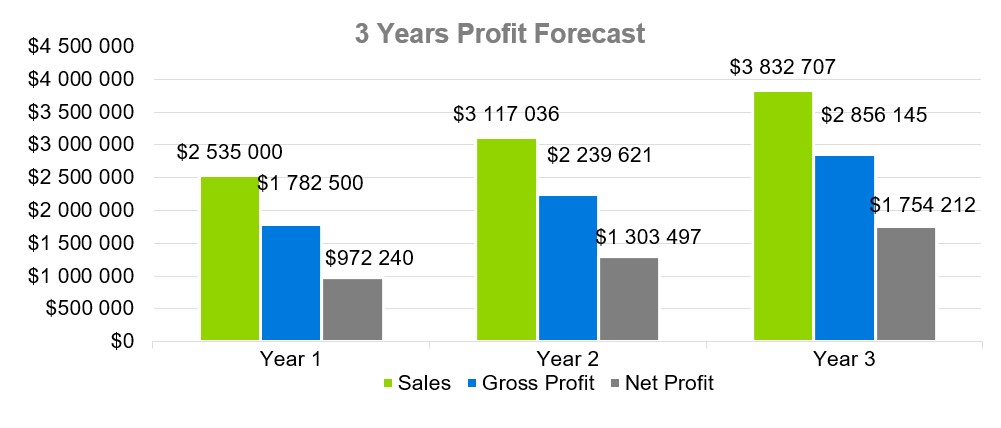
Company Summary
3.1 Company Owner
Tom Niro will be the owner of Niro Transports. Niro has acquired a degree in Executive MBA. After excelling in his academic career, he went on to earn fame in the business world. Working for 4 years in the freight business, he earned a reputation as an honest and hard-working manager.
3.2 Why the transport business is being started
While working in the freight business, Niro came to have various transport ideas that he couldn’t implement due to having limited decision-making authority. Finally, he decided to exploit a transport business opportunity and manage it the way he wanted.
3.3 How the transport business will be started
As per the transport company business plan of Niro Transports, the following steps should be taken to start this business.
Step1: Plan & Take Down
The first step is to develop a business plan transport company. Your strategic plan should cover all aspects such as how to get a transport contract, what would be the broad guidelines for agreements done to the consumer businesses etc. This business plan for transport company pdf will be elaborating all those aspects for your help.
Step2: Recruit
The next step is to hire talented and hardworking employees for your business. For the transport sector, you will need to hire relatively more employees in managerial positions as well as for the posts of drivers.
Step3: Get the Vehicles
To conduct the transport business, you will need to purchase vehicles of different sizes and functionality.
Step4: Market with a Strong Web Presence
Lastly, you will need to ensure a strong web presence to advertise your venture. Moreover, offline media should also be used to ensure the marketing is done rightly.
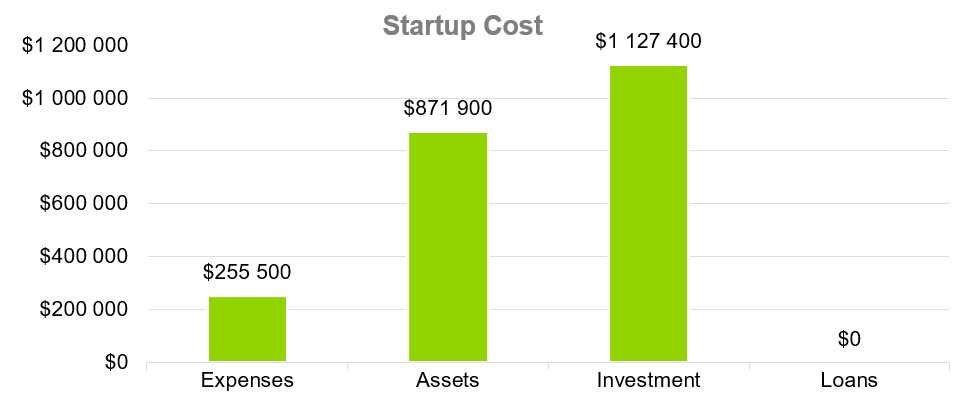
| Start-up Expenses | |
| Legal | $134,400 |
| Consultants | $0 |
| Insurance | $23,100 |
| Rent | $31,400 |
| Research and Development | $10,000 |
| Expensed Equipment | $53,200 |
| Signs | $3,400 |
| TOTAL START-UP EXPENSES | $255,500 |
| Start-up Assets | $213,400 |
| Cash Required | $181,000 |
| Start-up Inventory | $35,100 |
| Other Current Assets | $231,000 |
| Long-term Assets | $211,400 |
| TOTAL ASSETS | $871,900 |
| Total Requirements | $1,127,400 |
| START-UP FUNDING | |
| Start-up Expenses to Fund | $255,500 |
| Start-up Assets to Fund | $871,900 |
| TOTAL FUNDING REQUIRED | $1,127,400 |
| Assets | |
| Non-cash Assets from Start-up | $1,120,400 |
| Cash Requirements from Start-up | $135,300 |
| Additional Cash Raised | $50,000 |
| Cash Balance on Starting Date | $35,000 |
| TOTAL ASSETS | $1,340,700 |
| Liabilities and Capital | |
| Liabilities | $13,600 |
| Current Borrowing | $0 |
| Long-term Liabilities | $0 |
| Accounts Payable (Outstanding Bills) | $63,500 |
| Other Current Liabilities (interest-free) | $0 |
| TOTAL LIABILITIES | $77,100 |
| Capital | |
| Planned Investment | $1,127,400 |
| Investor 1 | $0 |
| Investor 2 | $0 |
| Other | $0 |
| Additional Investment Requirement | $0 |
| TOTAL PLANNED INVESTMENT | $1,127,400 |
| Loss at Start-up (Start-up Expenses) | $136,200 |
| TOTAL CAPITAL | $1,263,600 |
| TOTAL CAPITAL AND LIABILITIES | $1,340,700 |
| Total Funding | $1,127,400 |
Operational/Strategic Planning Services
Services of transport business
If you are starting your own transport business it would be good to have your hands on multiple transport business opportunities. For that, you should study many sample trucking business plans and notice which type of services they are providing. Since the services may overlap with those of other enterprises, it is advisable to also consult passenger transport business plan and general freight trucking business plan.
In this transport business plan, we are providing the services of Niro Transports so that you can have help with your transport proposal, if you plan to enter transport services business.
- Transporting Food Items
Our major service will be transporting raw food materials to the industries that deal in food products. We will also transport the raw items to hotels and motels that need an influx of new material on daily basis.
- Home Shifting
We will also serve in the arena of house shifting. To move the furniture and household appliances, we will provide both the vehicles and drivers.
- Transporting Construction Material
We will also serve in the construction sector. We will procure vehicles specialized in functionality to carry grit, concrete, bricks, and other construction materials.
- Transporting General Goods
We will provide vehicles and drivers to enable transportation to and from manufacturing bases.
Marketing Analysis of transport business
excellent work
excellent work, competent advice.
Alex is very friendly, great communication.
100% I recommend CGS capital.
Thank you so much for your hard work!
There are various types of transport business and depending on your interest and area, the marketing analysis can be entirely different. For instance, if you are more towards transporting general goods, you would need trucking business plan doc.
For marketing analysis, you have to study how many businesses of the same type are operating near your startup. Moreover, you should study their respective strategies to conduct the business so to know how to succeed in transport business in that locality.
Since Niro decided to provide a myriad of services, the transport business plan developed by him can be taken as general guidance. If you are starting a transport business in any city, you can have help from here. You can get transport business tips, and a complete guidance on how to run transport business and how to manage transport business.
5.1 Market Trends
In the United States, more than 40k businesses are successfully running in each category such as freight packing and logistics, water transportation, moving services, taxi services, etc. Owners of these businesses are earning profits in billions in each category, as per the specified statistics by IBISWorld.
The market trends are promising and therefore if you are thinking about starting a transport business, you must go for it. Here is a complete guide on how to register a transport company and how to run a transport company for information.
5.2 Marketing Segmentation
The customers of the transport business are almost the same as those mentioned in starting a towing business plan and starting logistics business plan.
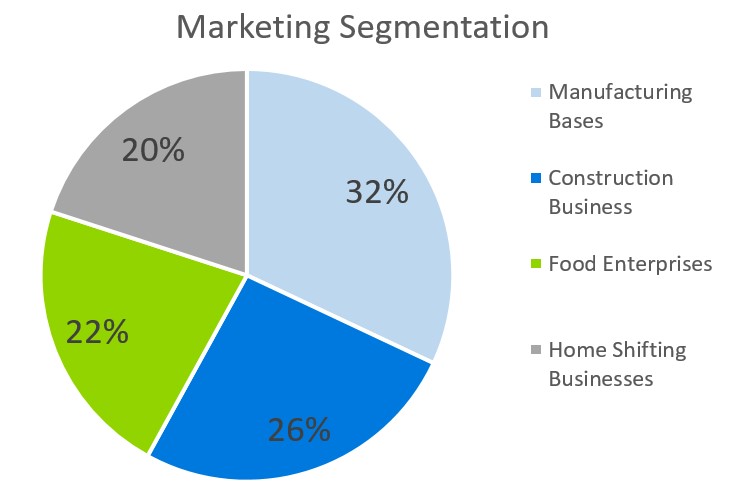
5.2.1 Manufacturing Bases
The biggest category of our target customers will be the manufacturing bases. They will need our services to get the raw materials, tools, and machinery transported to their sites. They will also need us to transport the finished products in bulk.
5.2.2 Construction Business
The construction businesses will be utilizing our services to get the construction material transported. In Atlanta, several construction businesses are located near the place where we have established ourselves. And thus, working with them will save us time and money.
5.2.3 Food Enterprises
Companies that prepare packed food items from the raw materials and hotels that cook their own meals will acquire our services.
5.2.4 Home Shifting Businesses
People who do jobs usually possess a car or any vehicle for the commute. However, still, some of them are expected to avail themselves of our services.
| Market Analysis | |||||||
| Potential Customers | Growth | Year 1 | Year 2 | Year 3 | Year 4 | Year 5 | CAGR |
| Manufacturing Bases | 32% | 43,100 | 51,720 | 62,064 | 74,477 | 89,372 | 10.00% |
| Construction Business | 26% | 33,100 | 39,720 | 47,664 | 57,197 | 68,636 | 10.00% |
| Food Enterprises | 22% | 22,700 | 27,240 | 32,688 | 39,226 | 47,071 | 10.00% |
| Home Shifting Businesses | 20% | 14,300 | 17,160 | 20,592 | 24,710 | 29,652 | 11.00% |
| Total | 100% | 113,200 | 135,840 | 163,008 | 195,610 | 234,732 | 10% |
5.3 Business Target
Niro Transports aim to meet the following business targets:
- Acquiring a CSAT score of 90+ within a year of the launch
- Expanding the business activity to one more location by the end of the first five years
- Start making at least $30k in monthly profits by the end of the first three years
5.4 Product Pricing
For the initial two years, we aim to keep our prices slightly less than our competitors. This will be done to expand the reach. However, following this time duration, we will raise the prices such that they become almost equivalent to those of our competitors.
Marketing Strategy of transport business
Running a transport business demands huge investment in terms of both time and money. And unless you have the mindset determined enough, you would feel difficulty managing the business. Just searching on Google for I want to start transport business wouldn’t suffice. You have to research how to start a transport business in your preferred city. Moreover, you have to craft a business proposal for transport services.
The sales strategy of Niro Transports is given in this business plan of a transport company.
6.1 Competitive Analysis
- Our biggest competitive advantage is our strategic location near all the giant organizations that we aim to serve.
- Secondly, we are especially focusing on reaching a maximum number of customers whether that means parting from monetary benefits. This strategy when carefully continued will benefit us in the longer run.
6.2 Sales Strategy
- We will create and brand posters based on memes so that more and more people see and share them.
- We will offer a 10% discount to hotels for the first year of our launch.
- We will set up a photography base with some vehicles culturally decorated so that teens and youngsters could capture pictures and share our brand name.
For more advertisement ideas, you may want to visit dump truck business plan sample as well as taxi company business plan.
6.3 Sales Monthly
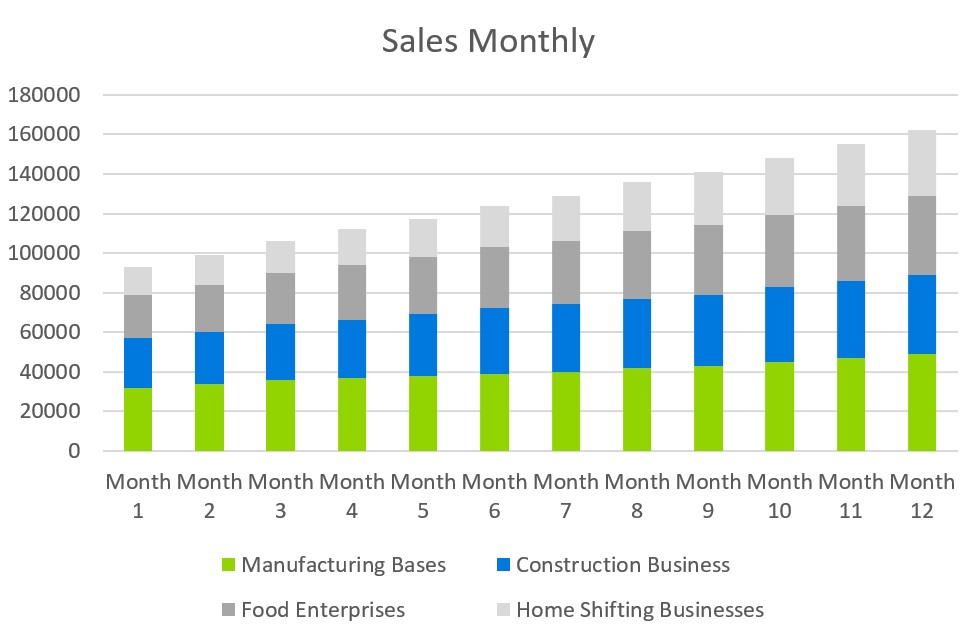
6.4 Sales Yearly
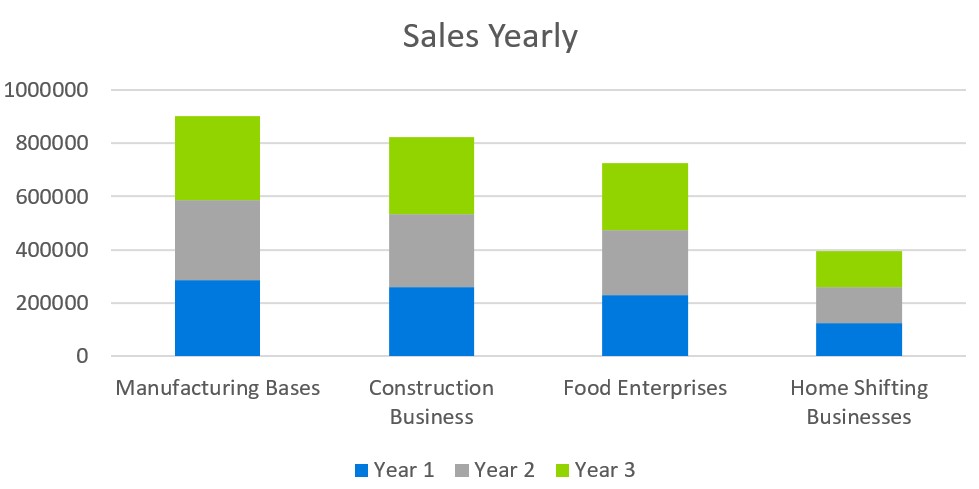
6.5 Sales Forecast
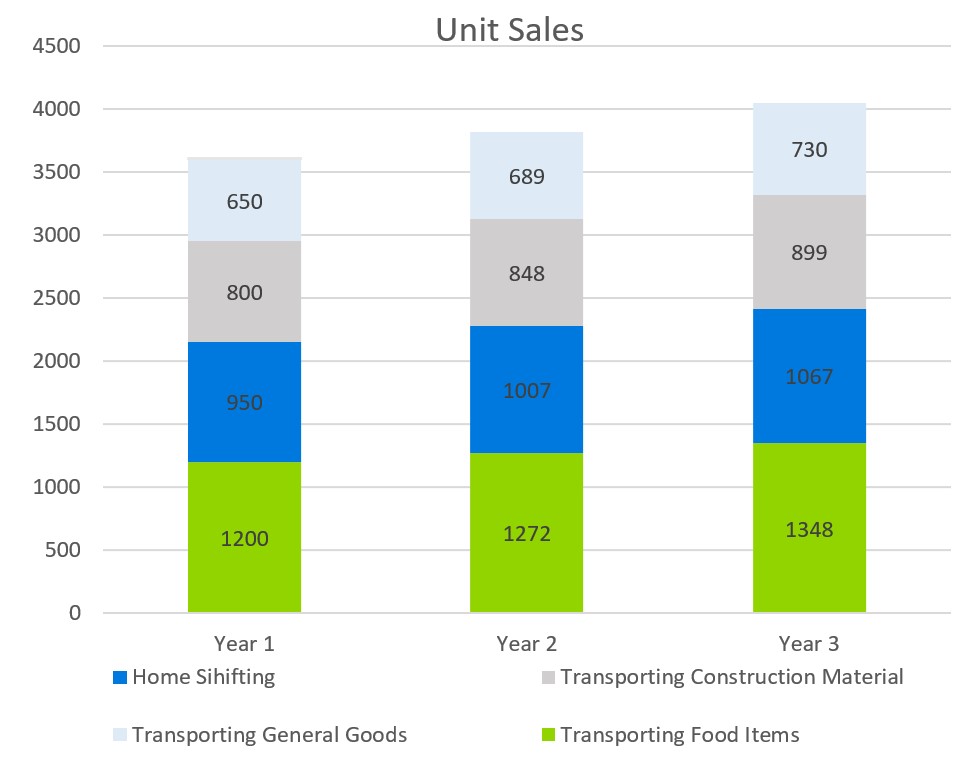
| Sales Forecast | |||
| Unit Sales | Year 1 | Year 2 | Year 3 |
| Transporting Food Items | 1,200 | 1,272 | 1,348 |
| Home Shifting | 950 | 1,007 | 1,067 |
| Transporting Construction Material | 800 | 848 | 899 |
| Transporting General Goods | 650 | 689 | 730 |
| TOTAL UNIT SALES | 3,600 | 3,816 | 4,045 |
| Unit Prices | Year 1 | Year 2 | Year 3 |
| Transporting Food Items | $600.00 | $696.00 | $807.36 |
| Home Shifting | $500.00 | $580.00 | $672.80 |
| Transporting Construction Material | $700.00 | $812.00 | $941.92 |
| Transporting General Goods | $1,200.00 | $1,392.00 | $1,614.72 |
| Sales | |||
| Transporting Food Items | $720,000.00 | $885,312.00 | $1,088,579.64 |
| Home Shifting | $475,000.00 | $584,060.00 | $718,160.18 |
| Transporting Construction Material | $560,000.00 | $688,576.00 | $846,673.05 |
| Transporting General Goods | $780,000.00 | $959,088.00 | $1,179,294.60 |
| TOTAL SALES | $2,535,000.00 | $3,117,036.00 | $3,832,707.47 |
| Direct Unit Costs | Year 1 | Year 2 | Year 3 |
| Transporting Food Items | $200.00 | $220.00 | $231.00 |
| Home Shifting | $200.00 | $220.00 | $231.00 |
| Transporting Construction Material | $200.00 | $220.00 | $231.00 |
| Transporting General Goods | $250.00 | $275.00 | $288.75 |
| Direct Cost of Sales | |||
| Transporting Food Items | $240,000.00 | $279,840.00 | $311,461.92 |
| Home Shifting | $190,000.00 | $221,540.00 | $246,574.02 |
| Transporting Construction Material | $160,000.00 | $186,560.00 | $207,641.28 |
| Transporting General Goods | $162,500.00 | $189,475.00 | $210,885.68 |
| Subtotal Direct Cost of Sales | $752,500.00 | $877,415.00 | $976,562.90 |
Personnel plan of transport business
Most of the transport business depends on the dedication of drivers and the vigilance of managers. in your business plan transport company you must enlist the staff you would hire to fill up different positions. For your help, we are listing the personnel plan of Niro Transports in this transport business plan template free of cost. If you want to save the business plan for later use, you can download it from transport company business plan pdf.
7.1 Company Staff
Niro, the CEO, will hire the following people:
- 1 Operation Manager
- 2 Sales Executives
- 1 Digital Media Manager
- 1 Customer Care Executive
- 2 Technical Assistants (Mechanics)
- 8 Drivers
7.2 Average Salary of Employees
| Personnel Plan | |||
| Year 1 | Year 2 | Year 3 | |
| Operation Manager | $30,000 | $33,000 | $36,300 |
| Sales Executives | $58,500 | $64,350 | $70,785 |
| Digital Media Manager | $28,500 | $31,350 | $34,485 |
| Customer Care Executive | $28,500 | $31,350 | $34,485 |
| Technical Assistants (Mechanics) | $42,500 | $46,750 | $51,425 |
| Drivers | $200,000 | $220,000 | $242,000 |
| Total Salaries | $388,000 | $426,800 | $469,480 |
Financial Plan of transport business
Making a comprehensive financial plan is essential to ensure that your business generates profit and remains safe from getting into a loss. The financial plan should cover detailed planning for at least three years. It should entail the expected sales, investments, earnings, and the ratios mentioned below.
In this transporter business plan the financial plan that enabled Niro to earn huge profits is given free of cost. Through this transport business plan sample you can have an insight into how much one can earn through this business.
While you skim through, you must identify that your profit generation would depend a lot on your transport business ideas. It is because due to increased competition, one has to be ultra-competitive and hardworking to earn fame in this field.
8.1 Important Assumptions
| General Assumptions | |||
| Year 1 | Year 2 | Year 3 | |
| Plan Month | 1 | 2 | 3 |
| Current Interest Rate | 8.12% | 8.20% | 8.26% |
| Long-term Interest Rate | 8.40% | 8.44% | 8.47% |
| Tax Rate | 24.03% | 24.21% | 24.60% |
| Other | 0 | 0 | 0 |
8.2 Break-even Analysis
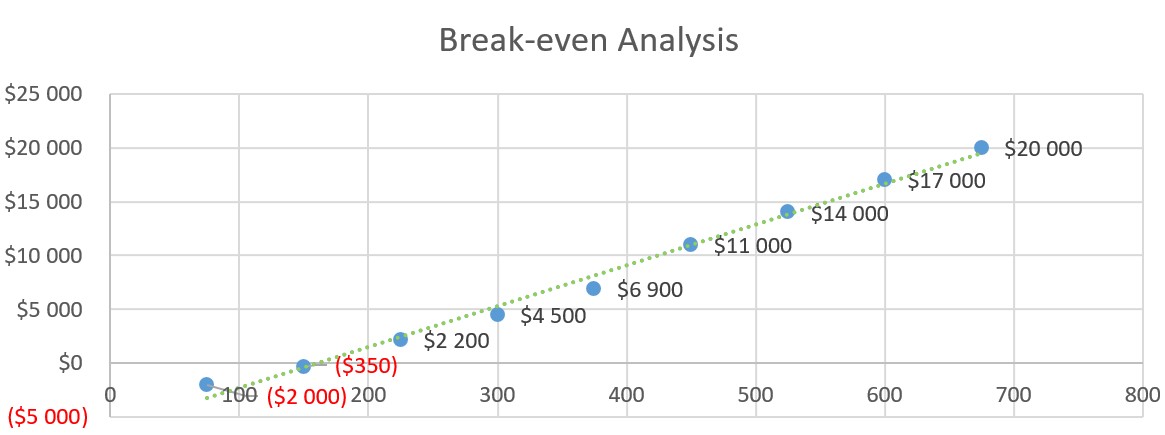
| Break-Even Analysis | |
| Monthly Units Break-even | 5340 |
| Monthly Revenue Break-even | $132,500 |
| Assumptions: | |
| Average Per-Unit Revenue | $231.00 |
| Average Per-Unit Variable Cost | $0.62 |
| Estimated Monthly Fixed Cost | $163,800 |
8.3 Projected Profit and Loss
| Pro Forma Profit And Loss | |||
| Year 1 | Year 2 | Year 3 | |
| Sales | $2,535,000 | $3,117,036 | $3,832,707 |
| Direct Cost of Sales | $752,500 | $877,415 | $976,563 |
| Other | $0 | $0 | $0 |
| TOTAL COST OF SALES | $752,500 | $877,415 | $976,563 |
| Gross Margin | $1,782,500 | $2,239,621 | $2,856,145 |
| Gross Margin % | 70.32% | 71.85% | 74.52% |
| Expenses | |||
| Payroll | $388,000 | $426,800 | $469,480 |
| Sales and Marketing and Other Expenses | $145,000 | $148,000 | $156,000 |
| Depreciation | $2,300 | $2,350 | $2,500 |
| Leased Equipment | $0 | $0 | $0 |
| Utilities | $2,900 | $3,000 | $3,100 |
| Insurance | $2,100 | $2,100 | $2,100 |
| Rent | $2,900 | $3,000 | $3,200 |
| Payroll Taxes | $24,000 | $25,000 | $27,000 |
| Other | $0 | $0 | $0 |
| Total Operating Expenses | $567,200 | $610,250 | $663,380 |
| Profit Before Interest and Taxes | $1,215,300 | $1,629,371 | $2,192,765 |
| EBITDA | $1,215,300 | $1,629,371 | $2,192,765 |
| Interest Expense | $0 | $0 | $0 |
| Taxes Incurred | $243,060 | $325,874 | $438,553 |
| Net Profit | $972,240 | $1,303,497 | $1,754,212 |
| Net Profit/Sales | 38.35% | 41.82% | 45.77% |
8.3.1 Profit Monthly
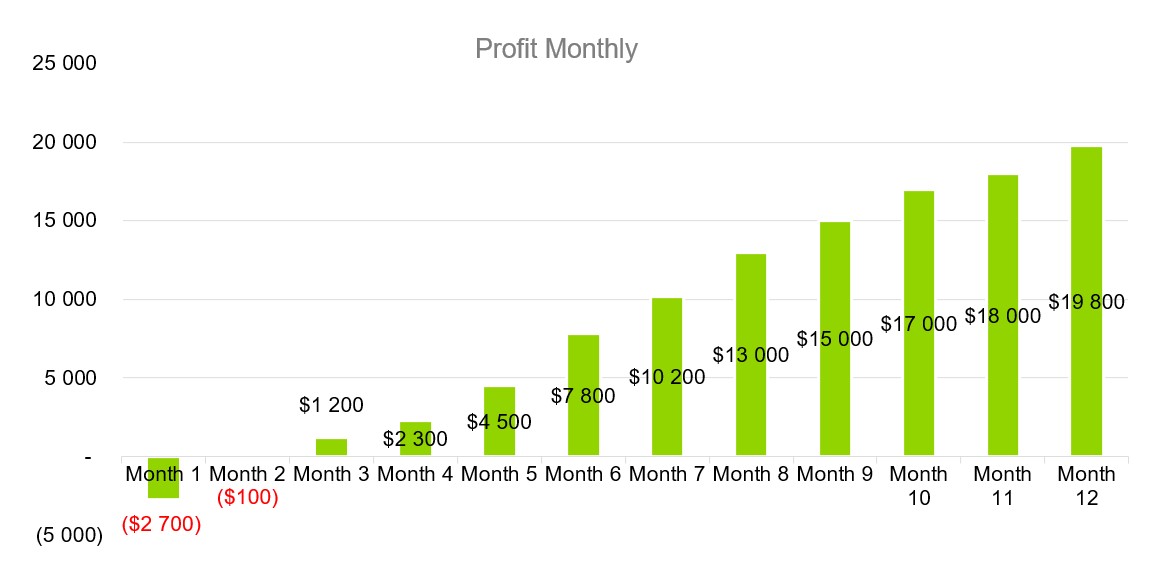
8.3.2 Profit Yearly
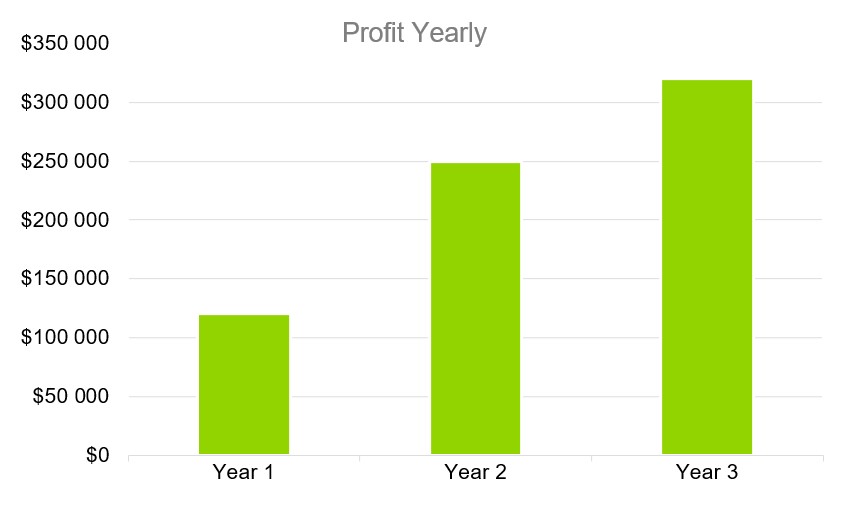
8.3.3 Gross Margin Monthly
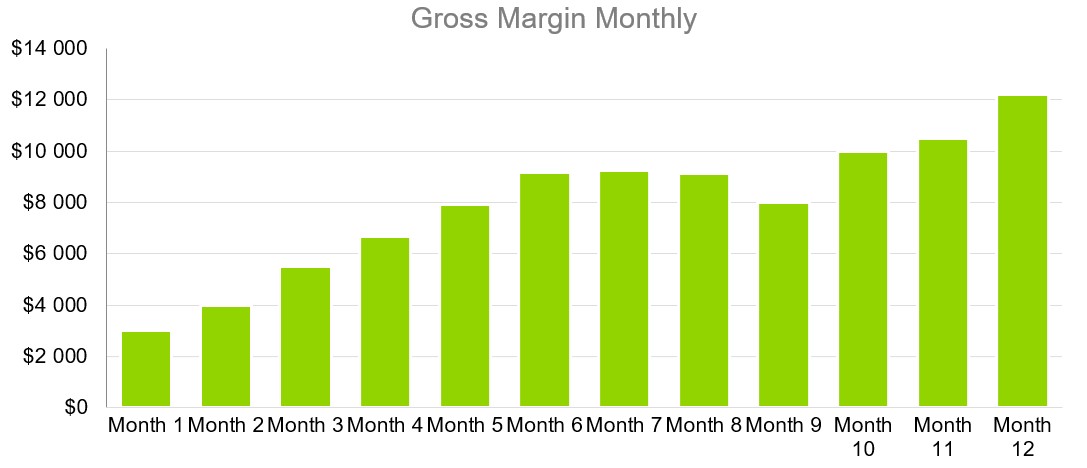
8.3.4 Gross Margin Yearly
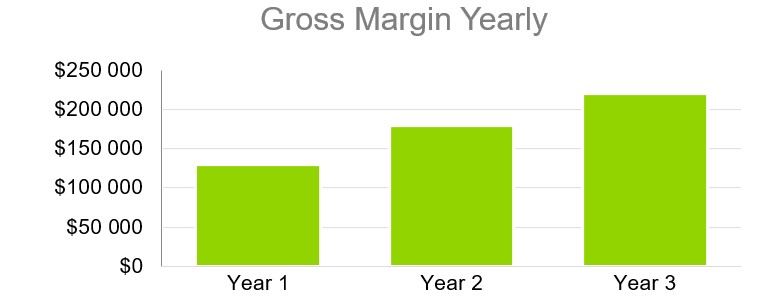
8.4 Projected Cash Flow
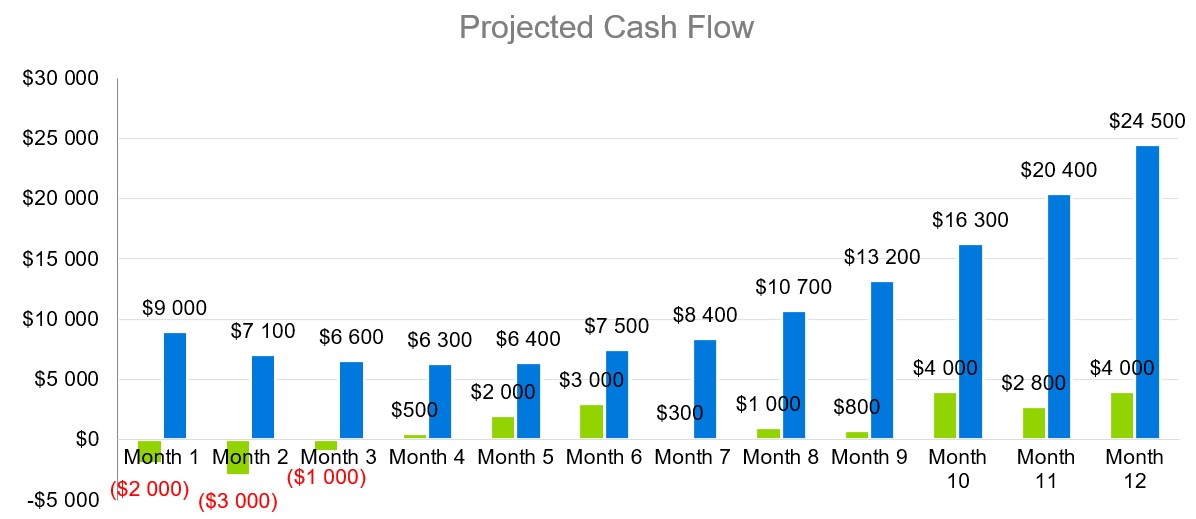
| Pro Forma Cash Flow | |||
| Cash Received | Year 1 | Year 2 | Year 3 |
| Cash from Operations | |||
| Cash Sales | $51,000 | $55,080 | $59,486 |
| Cash from Receivables | $22,000 | $23,760 | $25,661 |
| SUBTOTAL CASH FROM OPERATIONS | $73,000 | $79,570 | $85,936 |
| Additional Cash Received | |||
| Sales Tax, VAT, HST/GST Received | $0 | $0 | $0 |
| New Current Borrowing | $0 | $0 | $0 |
| New Other Liabilities (interest-free) | $0 | $0 | $0 |
| New Long-term Liabilities | $0 | $0 | $0 |
| Sales of Other Current Assets | $0 | $0 | $0 |
| Sales of Long-term Assets | $0 | $0 | $0 |
| New Investment Received | $0 | $0 | $0 |
| SUBTOTAL CASH RECEIVED | $74,000 | $79,000 | $85,000 |
| Expenditures | Year 1 | Year 2 | Year 3 |
| Expenditures from Operations | |||
| Cash Spending | $42,000 | $42,000 | $45,000 |
| Bill Payments | $27,000 | $28,000 | $31,000 |
| SUBTOTAL SPENT ON OPERATIONS | $69,000 | $70,000 | $76,000 |
| Additional Cash Spent | |||
| Sales Tax, VAT, HST/GST Paid Out | $0 | $0 | $0 |
| Principal Repayment of Current Borrowing | $0 | $0 | $0 |
| Other Liabilities Principal Repayment | $0 | $0 | $0 |
| Long-term Liabilities Principal Repayment | $0 | $0 | $0 |
| Purchase Other Current Assets | $0 | $0 | $0 |
| Purchase Long-term Assets | $0 | $0 | $0 |
| Dividends | $0 | $0 | $0 |
| SUBTOTAL CASH SPENT | $69,000 | $74,520 | $80,482 |
| Net Cash Flow | $21,000 | $23,000 | $25,000 |
| Cash Balance | $27,000 | $30,000 | $33,000 |
8.5 Projected Balance Sheet
| Pro Forma Balance Sheet | |||
| Assets | Year 1 | Year 2 | Year 3 |
| Current Assets | |||
| Cash | $275,000 | $308,000 | $338,800 |
| Accounts Receivable | $24,000 | $26,880 | $30,213 |
| Inventory | $4,300 | $4,816 | $4,900 |
| Other Current Assets | $1,000 | $1,000 | $1,000 |
| TOTAL CURRENT ASSETS | $282,000 | $315,840 | $355,004 |
| Long-term Assets | |||
| Long-term Assets | $10,000 | $10,000 | $10,000 |
| Accumulated Depreciation | $19,400 | $21,728 | $24,444 |
| TOTAL LONG-TERM ASSETS | $24,400 | $27,328 | $30,744 |
| TOTAL ASSETS | $294,000 | $329,280 | $370,440 |
| Liabilities and Capital | Year 4 | Year 5 | Year 6 |
| Current Liabilities | |||
| Accounts Payable | $18,700 | $20,944 | $23,541 |
| Current Borrowing | $0 | $0 | $0 |
| Other Current Liabilities | $0 | $0 | $0 |
| SUBTOTAL CURRENT LIABILITIES | $19,000 | $21,280 | $23,919 |
| Long-term Liabilities | $0 | $0 | $0 |
| TOTAL LIABILITIES | $15,000 | $16,800 | $18,883 |
| Paid-in Capital | $30,000 | $30,000 | $31,000 |
| Retained Earnings | $53,000 | $57,770 | $63,547 |
| Earnings | $193,400 | $210,806 | $231,887 |
| TOTAL CAPITAL | $285,000 | $310,650 | $341,715 |
| TOTAL LIABILITIES AND CAPITAL | $300,000 | $329,280 | $370,440 |
| Net Worth | $293,400 | $319,806 | $351,787 |
8.6 Business Ratios
| Ratio Analysis | ||||
| Year 1 | Year 2 | Year 3 | INDUSTRY PROFILE | |
| Sales Growth | 7.25% | 8.03% | 8.90% | 3.00% |
| Percent of Total Assets | ||||
| Accounts Receivable | 9.21% | 10.20% | 11.31% | 9.80% |
| Inventory | 5.39% | 5.97% | 6.62% | 9.90% |
| Other Current Assets | 2.11% | 2.34% | 2.59% | 2.40% |
| Total Current Assets | 149.80% | 151.00% | 152.00% | 158.00% |
| Long-term Assets | 11.55% | 11.60% | 11.64% | 12.00% |
| TOTAL ASSETS | 100.00% | 100.00% | 100.00% | 100.00% |
| Current Liabilities | 4.90% | 4.94% | 4.98% | 4.34% |
| Long-term Liabilities | 0.00% | 0.00% | 0.00% | 0.00% |
| Total Liabilities | 7.59% | 7.65% | 7.72% | 7.38% |
| NET WORTH | 100.45% | 101.25% | 102.19% | 110.00% |
| Percent of Sales | ||||
| Sales | 100.00% | 100.00% | 100.00% | 100.00% |
| Gross Margin | 94.60% | 97.15% | 99.87% | 99.00% |
| Selling, General & Administrative Expenses | 93.56% | 96.09% | 98.78% | 97.80% |
| Advertising Expenses | 1.52% | 1.56% | 1.60% | 1.40% |
| Profit Before Interest and Taxes | 41.50% | 42.62% | 43.81% | 33.90% |
| Main Ratios | ||||
| Current | 34 | 35 | 36 | 32 |
| Quick | 33 | 33.8 | 34.645 | 33 |
| Total Debt to Total Assets | 0.18% | 0.18% | 0.17% | 0.40% |
| Pre-tax Return on Net Worth | 74.08% | 74.89% | 75.00% | 75.00% |
| Pre-tax Return on Assets | 96.30% | 101.12% | 106.17% | 111.30% |
| Additional Ratios | Year 1 | Year 2 | Year 3 | |
| Net Profit Margin | 33.56% | 34.60% | 35.67% | N.A. |
| Return on Equity | 55.80% | 57.53% | 59.31% | N.A. |
| Activity Ratios | ||||
| Accounts Receivable Turnover | 7.7 | 7.8 | 7.8 | N.A. |
| Collection Days | 100 | 100 | 100 | N.A. |
| Inventory Turnover | 32.4 | 34.02 | 35 | N.A. |
| Accounts Payable Turnover | 15.6 | 16 | 16.3 | N.A. |
| Payment Days | 27 | 27 | 27 | N.A. |
| Total Asset Turnover | 2.5 | 2.5 | 2.6 | N.A. |
| Debt Ratios | ||||
| Debt to Net Worth | -0.04 | -0.03 | -0.04 | N.A. |
| Current Liab. to Liab. | 1 | 1 | 1 | N.A. |
| Liquidity Ratios | ||||
| Net Working Capital | $244,000 | $257,664 | $272,093 | N.A. |
| Interest Coverage | 0 | 0 | 0 | N.A. |
| Additional Ratios | ||||
| Assets to Sales | 0.85 | 0.87 | 0.89 | N.A. |
| Current Debt/Total Assets | 1% | 0% | 0% | N.A. |
| Acid Test | 29 | 29.12 | 29.16 | N.A. |
| Sales/Net Worth | 2.1 | 2.2 | 2.2 | N.A. |
| Dividend Payout | 0 | 0 | 0 | N.A. |
FAQ
- What is the most profitable transportation business?
Goods transport business is profitable in all domains and entirety. Though air transportation is considered the most profitable, the fact is you can make immense profits in other domains with relative ease and freedom.
- How do you write a transportation proposal?
To write a business plan for transport, you need to have an understanding of business terms and trends. It is good to hire a specialist to make a transport company business plan for you. For an idea about what the transport business plan would look like, you can see this sample business plan transport company.
- What are the 4 types of transportation?
The 4 types of transportation are Marine Transportation, Air Transportation, Road Transportation, and Rail Transportation.
- How can I start a small transport business in the USA?
To start the transport business in any U.S. city, you need to first get transport company registration. Further steps can be seen in detail from this blog on how to start a transport company in any city.




 (10 votes, average: 4.70 out of 5)
(10 votes, average: 4.70 out of 5)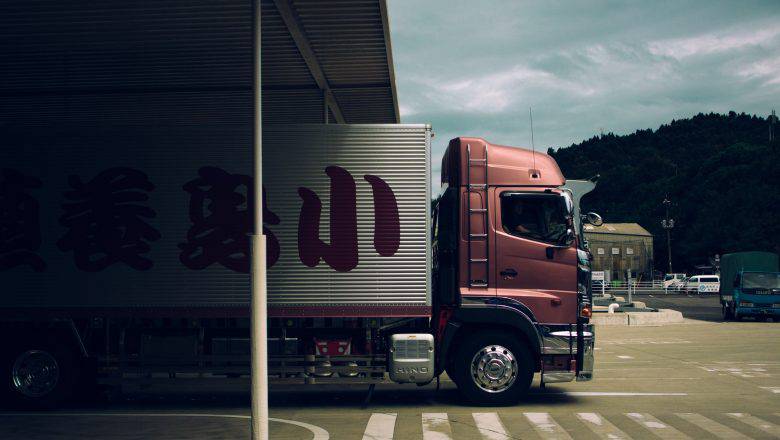





Add comment
Comments (0)